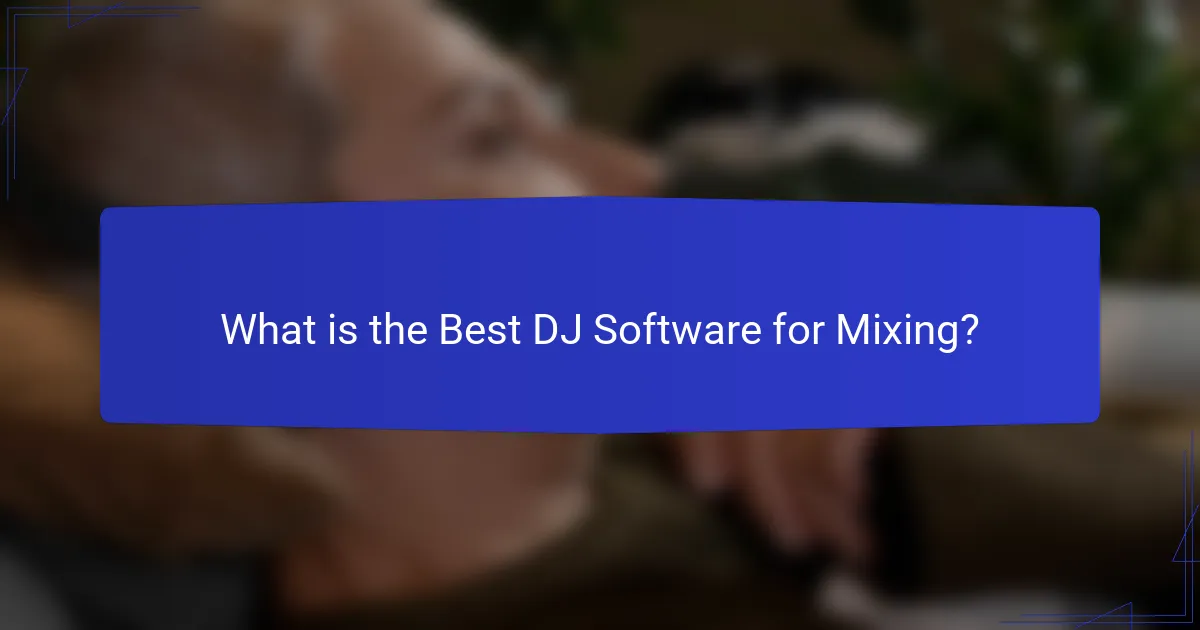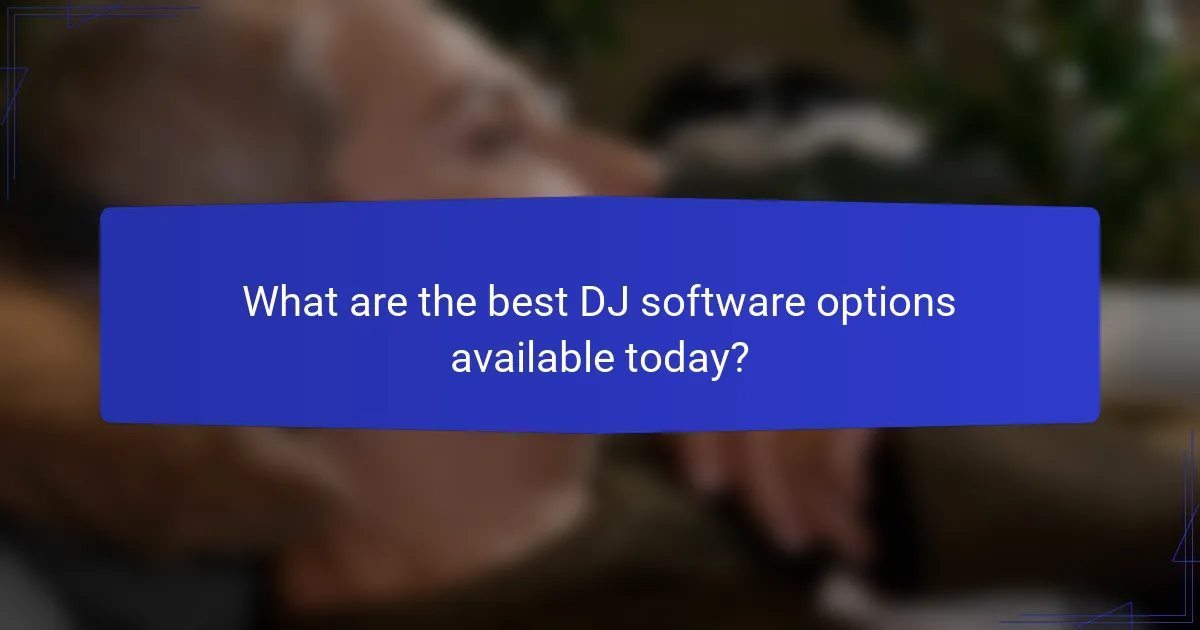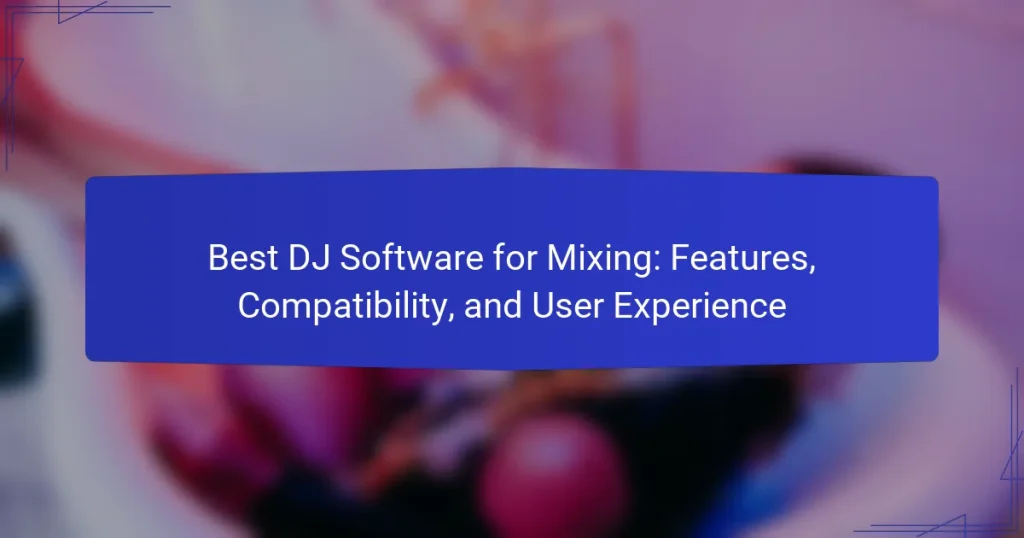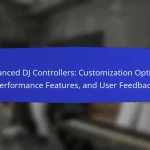Serato DJ Pro is a leading DJ software known for its user-friendly interface, extensive hardware compatibility, and advanced features such as beatmatching and effects. This article explores the best DJ software for mixing, focusing on key factors that influence user experience, including interface design, performance stability, and feature sets. It also compares Serato DJ Pro with other popular options like Traktor Pro 3 and Rekordbox DJ, highlighting their unique attributes and support for various audio formats. The discussion emphasizes the importance of community resources and regular updates in maintaining software relevance and enhancing functionality for professional DJs.

What is the Best DJ Software for Mixing?
Serato DJ Pro is considered one of the best DJ software for mixing. It offers a user-friendly interface and supports a wide range of hardware. The software is compatible with various operating systems, including Windows and macOS. It provides advanced features like beatmatching and effects. Serato DJ Pro also includes a library management system for organizing music. Many professional DJs prefer it for live performances. Its reliability and performance have been proven in numerous club settings. Additionally, it has a large community for support and resources.
How does DJ software enhance the mixing process?
DJ software enhances the mixing process by providing advanced tools and features that streamline audio manipulation. It allows DJs to mix multiple tracks seamlessly, enabling smooth transitions between songs. Features like beat matching automatically align tempos, facilitating synchronized playback. Additionally, effects such as reverb and echo can be applied in real-time, adding depth to the mix. Visual waveforms display track structures, helping DJs identify key points for mixing. Many DJ software options support MIDI controllers, enhancing tactile control over the mixing process. These capabilities contribute to a more creative and efficient workflow for DJs.
What are the key functionalities of DJ software?
DJ software provides essential functionalities for mixing music. These include track playback, beat matching, and tempo adjustment. Users can manipulate audio effects and apply filters to enhance sound quality. The software often features a mixer interface for controlling volume levels and EQ settings. Many DJ software applications support various audio formats for versatility. They also allow for live performance capabilities, enabling real-time mixing and transitions. Additionally, some programs offer loop and sample integration for creative remixing. Finally, advanced features may include MIDI controller support for enhanced user interaction.
How does DJ software differ from traditional mixing methods?
DJ software allows for digital mixing, while traditional methods use physical equipment like turntables. Digital mixing provides features such as beatmatching, looping, and effects that are often automated. Traditional mixing requires manual adjustment and skill to blend tracks seamlessly. DJ software also offers a vast library of digital music, while traditional methods are limited to physical media. Additionally, DJ software can integrate with various hardware, enhancing versatility. This flexibility enables DJs to perform in diverse environments, from clubs to home setups. Overall, DJ software streamlines the mixing process and expands creative possibilities compared to traditional methods.
What are the essential features to look for in DJ software?
Essential features to look for in DJ software include user interface, compatibility, and audio effects. A user-friendly interface allows for easy navigation and quick access to controls. Compatibility with various operating systems and hardware is crucial for flexibility. Audio effects enhance sound quality and creativity during performances. Additionally, features like beat matching and looping are important for seamless mixing. Support for multiple file formats ensures versatility in music selection. Built-in tutorials can assist beginners in learning the software effectively. These features contribute to an overall positive user experience, making the software more effective for DJs.
Which features improve user experience in DJ software?
Intuitive interface design improves user experience in DJ software. Users benefit from a layout that allows easy navigation and quick access to essential tools. Customizable controls enhance personalization, enabling DJs to tailor the software to their preferences. High-quality audio processing ensures clear sound output, which is crucial for live performances. Compatibility with various hardware, like controllers and mixers, expands functionality and flexibility. Real-time effects and transitions provide creative options for mixing, keeping the performance engaging. Additionally, features like beatmatching and syncing automate complex tasks, allowing DJs to focus on creativity. These features collectively contribute to a smoother and more enjoyable user experience.
What role do effects and filters play in DJ software?
Effects and filters in DJ software enhance sound quality and creativity. They allow DJs to manipulate audio tracks in real-time. Effects can include reverb, delay, and distortion, which add depth and texture to music. Filters, such as high-pass and low-pass, enable frequency adjustment, shaping the sound further. These tools help create transitions between tracks, maintain energy, and engage the audience. The use of effects and filters is essential for live performances, making them a core feature of modern DJ software. Studies show that effective use of these tools can significantly improve audience experience during live sets.
How does compatibility influence the choice of DJ software?
Compatibility significantly influences the choice of DJ software by determining how well the software integrates with existing hardware and operating systems. DJs require software that works seamlessly with their controllers, mixers, and audio interfaces. If the software is incompatible with key hardware, it can lead to performance issues and hinder creativity.
Moreover, compatibility with various file formats ensures that DJs can access their music libraries without restrictions. Popular DJ software often supports multiple audio formats, enhancing usability. Additionally, operating system compatibility is crucial; software must be compatible with Windows, macOS, or Linux, depending on the user’s setup.
Research shows that 70% of DJs prioritize compatibility when selecting software, as noted in the “DJ Software Market Analysis” by DJ Tech Tools. This statistic underscores the importance of compatibility in making informed software choices.
What operating systems support popular DJ software?
Popular DJ software typically supports Windows, macOS, and sometimes Linux. For instance, software like Serato DJ and Traktor Pro are available on Windows and macOS. Additionally, some DJ applications, like Virtual DJ, also offer Linux compatibility. This multi-platform support allows DJs to choose their preferred operating system. Compatibility ensures that users can run the software on widely used systems. Therefore, Windows and macOS are the most common operating systems for popular DJ software.
How does hardware compatibility affect DJ software performance?
Hardware compatibility significantly influences DJ software performance. Compatible hardware ensures optimal functionality and responsiveness of the software. Incompatible hardware can lead to latency issues, glitches, and crashes. For instance, a DJ controller not supported by the software may not map controls correctly. This can hinder the DJ’s ability to perform seamlessly. Moreover, insufficient processing power can cause the software to lag during live performances. Testing compatibility with specific hardware is crucial for reliable operation. Many DJ software providers list compatible hardware on their websites to assist users.

What factors contribute to user experience in DJ software?
User experience in DJ software is influenced by several key factors. These include interface design, which affects ease of navigation and usability. Performance stability is crucial, as it ensures seamless mixing without crashes or delays. Feature set is also significant; essential tools like effects, loops, and samples enhance creativity. Compatibility with hardware and other software ensures flexibility in different setups. User support and community resources contribute to learning and troubleshooting. Finally, regular updates improve functionality and security, keeping the software relevant.
How does the interface design impact usability?
Interface design significantly impacts usability by influencing user interaction efficiency. A well-designed interface enhances navigation and reduces the learning curve for users. Intuitive layouts allow users to find features quickly, improving task completion times. Consistent visual elements create familiarity, which aids in user retention. According to a study by Nielsen Norman Group, 94% of first impressions relate to design. This indicates that effective interface design can lead to higher user satisfaction and engagement. Therefore, poor design can frustrate users, leading to decreased productivity and increased errors.
What are the best practices for navigating DJ software interfaces?
Familiarize yourself with the layout of the DJ software interface. Understanding the arrangement of controls enhances usability. Utilize the software’s tutorial or help section for guidance. Many DJ software programs offer built-in tutorials. Customize your workspace to fit your workflow preferences. This can improve efficiency and speed during performances. Use keyboard shortcuts to streamline your navigation. Shortcuts can significantly reduce time spent on manual tasks. Regularly practice navigating the interface to build muscle memory. Familiarity with the software leads to more fluid performances. Lastly, keep the software updated to access the latest features and improvements. Updates often include enhancements that improve user experience.
How does customization enhance user experience?
Customization enhances user experience by allowing users to tailor software settings to their preferences. This personalization leads to increased satisfaction and engagement. Users can modify layouts, controls, and features according to their workflow. For instance, DJ software often enables users to assign specific functions to buttons or sliders. This flexibility can improve efficiency and comfort during performances. Studies show that personalized interfaces can significantly boost user productivity. Research indicates that 80% of users prefer software that adapts to their individual needs. Customization ultimately creates a more intuitive and enjoyable experience for users.
What is the importance of customer support for DJ software users?
Customer support is crucial for DJ software users. It ensures timely assistance with technical issues. Many users rely on software for live performances. A malfunction can disrupt an event. Effective customer support minimizes downtime. It also provides guidance on software features. Users benefit from troubleshooting tips and resources. According to a survey by Zendesk, 67% of customers say good support influences their loyalty. This highlights the importance of responsive customer service in retaining DJ software users.
How can responsive support improve user satisfaction?
Responsive support enhances user satisfaction by addressing issues promptly and effectively. Quick responses to user inquiries can reduce frustration. Users feel valued when their concerns are acknowledged immediately. This leads to a positive perception of the brand. A study by Zendesk found that 82% of consumers feel more positive about a company after receiving quick responses to their inquiries. Additionally, resolving problems efficiently can increase user loyalty. Satisfied users are more likely to recommend the service to others. Overall, responsive support directly correlates with improved user satisfaction levels.
What resources are available for troubleshooting DJ software issues?
Official support websites provide troubleshooting resources for DJ software issues. Many DJ software companies offer FAQs, user manuals, and forums. Online communities and forums, like DJ TechTools, allow users to share solutions. YouTube has tutorial videos addressing common software problems. Social media platforms often feature user groups for real-time assistance. Third-party websites may provide guides and tips for specific software issues. Manufacturer customer support can also assist with troubleshooting. These resources collectively help users resolve DJ software issues effectively.

What are the best DJ software options available today?
The best DJ software options available today include Serato DJ Pro, Traktor Pro 3, and Rekordbox DJ. Serato DJ Pro is known for its user-friendly interface and extensive hardware compatibility. Traktor Pro 3 offers advanced features like remix decks and powerful effects. Rekordbox DJ is favored for its integration with Pioneer DJ hardware and cloud library management. Each software supports various audio formats and provides tools for live performance. These options are widely used by professional DJs across the globe.
What are the top-rated DJ software programs on the market?
The top-rated DJ software programs on the market include Serato DJ Pro, Traktor Pro 3, and Rekordbox DJ. Serato DJ Pro is known for its user-friendly interface and extensive hardware compatibility. It supports a wide range of DJ controllers and mixers. Traktor Pro 3 offers advanced features like remix decks and powerful effects. It is favored by many professional DJs for its flexibility and customization options. Rekordbox DJ is popular for its integration with Pioneer DJ hardware. It provides features for both performance and music management. These programs are consistently rated highly due to their robust features and reliability in live settings.
What unique features do these top programs offer?
Top DJ software programs offer unique features that enhance user experience and mixing capabilities. Advanced beat matching algorithms ensure seamless transitions between tracks. Real-time audio effects allow for creative manipulation of sound during live performances. Customizable user interfaces enable DJs to tailor the layout to their preferences. Integration with various hardware, such as controllers and mixers, enhances functionality. Cloud storage options provide access to music libraries from anywhere. Support for multiple audio formats ensures compatibility with diverse music collections. Built-in tutorials and community forums facilitate learning and troubleshooting for users. These features collectively elevate the mixing experience for both beginners and professionals.
How do user reviews influence the perception of these software options?
User reviews significantly influence the perception of DJ software options. Positive reviews enhance credibility and attract potential users. They often highlight specific features that users find beneficial. Negative reviews can deter users by emphasizing flaws or shortcomings. Reviews also provide insights into user experience and compatibility with different systems. According to a study by BrightLocal, 91% of consumers read online reviews. This statistic underscores the importance of user feedback in shaping perceptions. Overall, user reviews serve as a critical factor in decision-making for potential buyers.
How can users choose the right DJ software for their needs?
Users can choose the right DJ software by assessing their specific needs and preferences. First, they should identify their skill level, whether beginner, intermediate, or professional. Next, users must consider the software’s features, such as effects, loops, and sampling capabilities. Compatibility with existing hardware is crucial, including controllers and audio interfaces. Users should also evaluate the software’s user interface for ease of navigation. Additionally, reading reviews and trying demo versions can provide insights into performance and usability. Finally, users should consider their budget, as prices can vary significantly among different software options.
What factors should beginners consider when selecting DJ software?
Beginners should consider several factors when selecting DJ software. These include user interface simplicity, as intuitive designs facilitate easier learning. Compatibility with hardware is crucial, ensuring the software works with existing equipment. Feature set is also important; beginners should look for essential tools like beatmatching and looping. Price is a significant factor; many software options offer free trials or budget-friendly versions. Learning resources, such as tutorials and community support, enhance the user experience. Lastly, updates and support from the software provider can impact long-term usability and performance.
What advanced features should professional DJs prioritize?
Professional DJs should prioritize features such as advanced effects processing, seamless integration with hardware, and customizable user interfaces. Advanced effects processing allows DJs to manipulate sound creatively. Seamless integration with hardware ensures compatibility with various DJ controllers and mixers. Customizable user interfaces enhance workflow efficiency. Additional features like real-time audio analysis and beatmatching tools improve performance quality. These features are vital for creating unique and engaging mixes.
What tips can enhance the experience of using DJ software?
To enhance the experience of using DJ software, users should familiarize themselves with the software’s features. Understanding effects, loops, and transitions can improve mixing quality. Regular practice helps users become more efficient and creative. Utilizing keyboard shortcuts can speed up workflow and improve live performance. Customizing the interface allows for a personalized setup that fits individual preferences. High-quality headphones are essential for accurate monitoring. Keeping the software updated ensures access to the latest features and fixes. Engaging with online communities can provide valuable tips and support from other DJs.
How can users optimize their setup for better performance?
Users can optimize their DJ setup for better performance by ensuring high-quality equipment and software. Investing in a powerful computer with sufficient RAM and processing speed enhances performance. Utilizing a dedicated audio interface reduces latency and improves sound quality. Keeping software updated ensures access to the latest features and bug fixes. Organizing music libraries efficiently allows for quicker access during performances. Using high-quality headphones provides better sound monitoring. Optimizing audio settings in the software can enhance output quality. Regularly testing the setup before live performances helps identify potential issues.
What common mistakes should users avoid when using DJ software?
Common mistakes users should avoid when using DJ software include not reading the manual. Many users skip this step and miss essential features. Another mistake is failing to organize music libraries effectively. Disorganized libraries can lead to wasted time during performances. Users often overlook the importance of practicing with the software. Inadequate practice can result in poor live performance. Additionally, not updating the software regularly can lead to bugs and compatibility issues. Users should also avoid relying solely on automatic features. Over-reliance can diminish creativity and skill development. Lastly, neglecting to back up settings and libraries can result in data loss. These mistakes can significantly impact the DJing experience.
The main entity of this article is DJ software, specifically focusing on the best options available for mixing music. The article provides an overview of key software like Serato DJ Pro, Traktor Pro 3, and Rekordbox DJ, highlighting their features, compatibility with various hardware and operating systems, and the importance of user experience. It discusses how DJ software enhances the mixing process through advanced functionalities such as beatmatching, audio effects, and real-time manipulation, while also addressing factors that influence user satisfaction, such as interface design and customer support. Additionally, the article offers guidance for both beginners and professional DJs on selecting the right software based on their specific needs and preferences.


